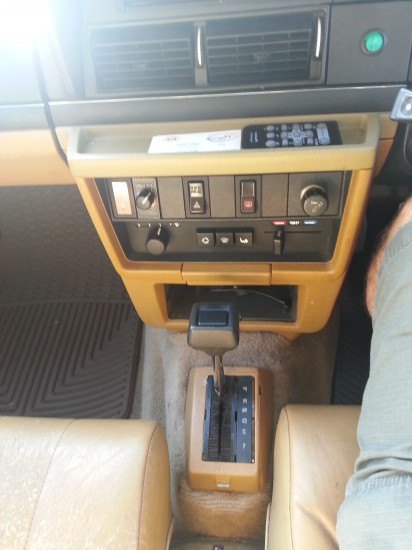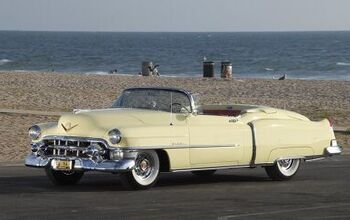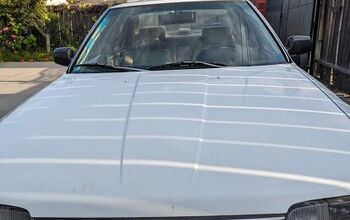Capsule Review: Volvo 240GL Estate

Volvo might have been one of the beneficiaries of the headlong rush towards European non-luxury in the Seventies but it, like Porsche, was permanently crippled by the American public’s confusion of “unhurried model cycle” with “should only make one specific car, forever”. For the boys from Stuttgart, it was the Yankee preference for the 911 that warped the next thirty years of their product plan into 911-looking things that were not at all like the 911, even if they said “911” on the rump.
Volvo made a different choice when they decided that the twenty-seven years between the 1966 debut of the 144 and the final 1993-model-year 240 were enough and that it was proper to make a clean break between those boxy RWD sedans and the boxy FWD sedans that followed. In so doing, they both doomed the company to permanent irrelevance and inadvertently created a cult.
Whenever the aliens finally come, they will no doubt conclude that Volvo stopped making automobiles in 1993 and didn’t start again until about five years before whatever the invasion date turns out to be. The successor 700- and 900-series cars often fell prey to the first generation of Europeansdon’tunderstandelectronicsitis. The 850 and its successors raise absolutely zero interest from anyone unless they have a “T5” or “R” on the decklid. The S80 is a lovely automobile but it doesn’t have any enthusiast following whatseover. The SUVs, of course, are as disposable as any other SUV without a practical tow rating.
For that reason, most of the Volvos you see on the streets nowadays fall into two categories:
- recent model, possibly under factory warranty
- 240DL or 240GL.
There’s just something about those old Volvos that inspires… passion. Most of them are now owned by young people who identify strongly with what the Volvo brand used to represent. They believe in the 240-series and they restore them for daily use, not the Cars-and-Coffee klatch. While the sedans are still popular, particularly the end-of-run aero-headlamp 240DL sedans, the hipster-Volvo equivalent of a ’63 Stingray Fuelie is the late 240 wagon.
As fate would have it, I’ve had a chance to experience two of these lately; a 240DL with glass E-code headlamps and a permanent interior cloud of cannabis smoke, in which I rode to a hilltop park outside Portland, and this 240GL, which I had the opportunity to drive around rural Ohio a few weekends ago. The DL was in like-new condition, thanks to a rust-free life on the West Coast and a thorough restoration at the hands of an owner with considerable mechanical aptitude. This GL isn’t nearly as perfect, being sourced from New York and with a reasonably long list of fixes yet to come, but it’s mechanically outstanding and a genuine pleasure to operate.
First things first: this is not a large car. Dimensionally it’s similar to the 2003 Accord. Opening the square-shouldered door and taking a seat, however, reveals a quality of seating and available space that both exceed what you’ll find in any Japanese-brand mid-sizer. The almost complete lack of tumblehome allows the seats to be both wide and widely spaced. The overall feeling is airy but solid, thanks to pillar thickness that was rare in any of the decades in which this model was sold.
The controls and instrumentation are absolutely straightforward, although the mouse-fur trim is no improvement over the more sparse appearance of the DL model. (Apparently there’s a bit of reverse snobbery among Volvo wagoneers, with the DL and its roll-up windows considered the more desirable car nowadays. More Volvo-ish, dontcha know.) Visibility is outstanding all the way ’round, with only the skeletonized rear headrests offering any significant impediment.
Even after more than twenty miles, this “estate” feels impeccably solid as I pull out onto a 45-mph back road. The steering is trustworthy and the brakes seem up to par. Acceleration, on the other hand…
The Volvo 240 of this era mustered 114 horsepower from its four-cylinder engine, but I’m not totally sure that all of them showed up for work in this particular example. It’s remarkably slow. To the customers who looked at the midsizer Volvo as an affordable alternative to the Mercedes-Benz W123 240D, it was probably a rocketship. Compared to a modern Hyundai Accent, it might as well be a diesel. (Yes, there was a diesel variant, but it did not survive to the Nineties in our market.) Progress is steady but in no way quick.
In just ten or so seconds, however, I’m up to 45mph and ready to try a little bit of the old swerving back and forth for purposes of warming tires and checking lateral stability. Well, there’s not much of that either. Best to calm it back down and just enjoy the Volvo’s core virtues. The ride is steady and relaxed, with plenty of compliance for potholes and rough shoulders. Ten minutes behind the wheel of the 240 will make you feel better about your place in the world, assuming you’re not in a hurry to get anywhere.
What’s not to like about the Volvo, other than the lack of pace? It’s spacious, comfortable, quiet, and reassuring. It’s entirely and refreshingly free of the merest pretense of “sportiness” and all the better for it. It feels as if it will last another twenty years without difficulty. The old phrase “boxy but good” applies here. The current Volvos feel uneasy in their own skins, half-heartedly going through the motions of enthusiast focus and swoopy design, but this is the real deal. I’d rather have this than any brand-new car in a Volvo showroom, both now and twenty years from now.
The Chinese owners of Volvo are no doubt perplexed by the long shadow this vehicle continues to cast on their current lineup. But if they had any sense at all, they’d dig up the old drawings and build it again — or at least come as close to it as the current Mustang does to the Sixties car. In a world where “brand” is all-important, the Volvo brand is nearly worthless. The Volvo 240 brand, on the other hand? That’s a moose of a different color.

More by Jack Baruth
Latest Car Reviews
Read moreLatest Product Reviews
Read moreRecent Comments
- Varezhka I have still yet to see a Malibu on the road that didn't have a rental sticker. So yeah, GM probably lost money on every one they sold but kept it to boost their CAFE numbers.I'm personally happy that I no longer have to dread being "upgraded" to a Maxima or a Malibu anymore. And thankfully Altima is also on its way out.
- Tassos Under incompetent, affirmative action hire Mary Barra, GM has been shooting itself in the foot on a daily basis.Whether the Malibu cancellation has been one of these shootings is NOT obvious at all.GM should be run as a PROFITABLE BUSINESS and NOT as an outfit that satisfies everybody and his mother in law's pet preferences.IF the Malibu was UNPROFITABLE, it SHOULD be canceled.More generally, if its SEGMENT is Unprofitable, and HALF the makers cancel their midsize sedans, not only will it lead to the SURVIVAL OF THE FITTEST ones, but the survivors will obviously be more profitable if the LOSERS were kept being produced and the SMALL PIE of midsize sedans would yield slim pickings for every participant.SO NO, I APPROVE of the demise of the unprofitable Malibu, and hope Nissan does the same to the Altima, Hyundai with the SOnata, Mazda with the Mazda 6, and as many others as it takes to make the REMAINING players, like the Excellent, sporty Accord and the Bulletproof Reliable, cheap to maintain CAMRY, more profitable and affordable.
- GregLocock Car companies can only really sell cars that people who are new car buyers will pay a profitable price for. As it turns out fewer and fewer new car buyers want sedans. Large sedans can be nice to drive, certainly, but the number of new car buyers (the only ones that matter in this discussion) are prepared to sacrifice steering and handling for more obvious things like passenger and cargo space, or even some attempt at off roading. We know US new car buyers don't really care about handling because they fell for FWD in large cars.
- Slavuta Why is everybody sweating? Like sedans? - go buy one. Better - 2. Let CRV/RAV rust on the dealer lot. I have 3 sedans on the driveway. My neighbor - 2. Neighbors on each of our other side - 8 SUVs.
- Theflyersfan With sedans, especially, I wonder how many of those sales are to rental fleets. With the exception of the Civic and Accord, there are still rows of sedans mixed in with the RAV4s at every airport rental lot. I doubt the breakdown in sales is publicly published, so who knows... GM isn't out of the sedan business - Cadillac exists and I can't believe I'm typing this but they are actually decent - and I think they are making a huge mistake, especially if there's an extended oil price hike (cough...Iran...cough) and people want smaller and hybrids. But if one is only tied to the quarterly shareholder reports and not trends and the big picture, bad decisions like this get made.







































Comments
Join the conversation
Jack, Next time you're in Cinci, give a holla and you can do a Capsule Review of my French Volvo 240 wagon, a 1989 Peugeot 505 SW8 turbo. Sorry it's not a Bentley Turbo R again, I've since gone a bit more pedestrian, lol.
I need a Pug wagon to go with my Volvo V90...the BMW Store used to sell them next door at the Peugeot Store, where MINI Cincinnati is now. I'll take a white one with gray mousefur seats, please.